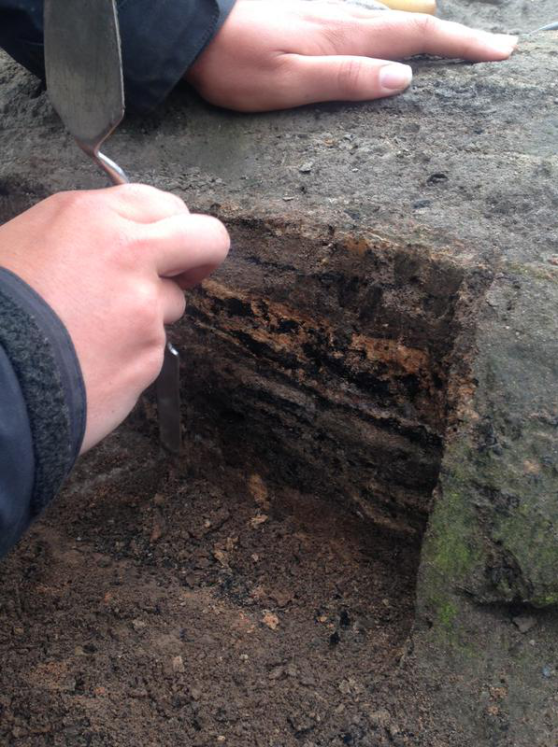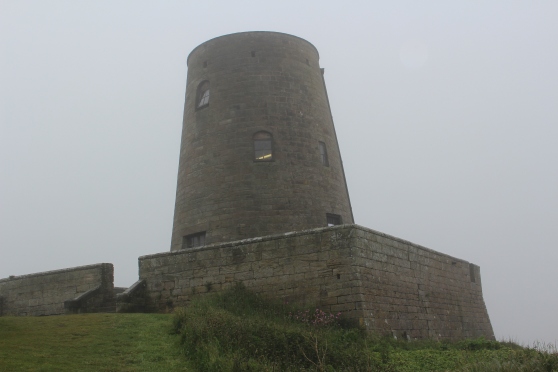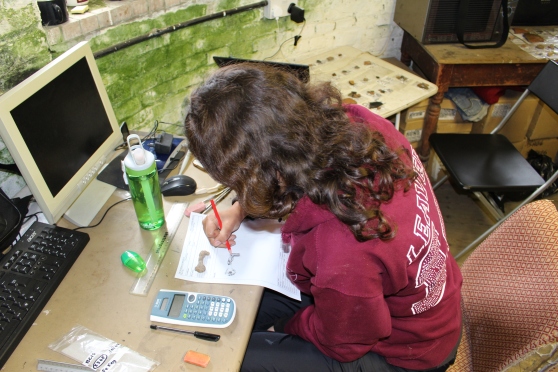In the past two weeks, apart from the usual excavation and recording process, Trench 3 did a number of hammerscale samples and two thin-sections, which is quite exciting! Today’s blog is all about elaborating on these processes, so that we may get more insight into different elements of archaeology.
Hammerscale Sampling
Hammerscale sampling is used to find out if a certain area of the trench was used for metalworking purposes. Last week we carried out a small number of hammerscale samples within the borders of our large timber building to see it it has been used for any metalworking.
Hammerscale is created when a blacksmith hammers iron; the sparks that fly off are actually tiny pieces of iron oxide that are only a couple of millimeters in size.
When we take hammerscale samples, we take a planning frame of 1x1m, which is divided into 25 smaller squares of 20x20cm. We then take small samples from each of these little squares. The hammerscale, hard to see with the naked eye, is magnetic, so when we run a magnet through each individual sample, any present hammerscale material will stick to the magnet, which is exactly what we want.

Hammerscale sampling
When labeling the bags we need to be mindful of the coordinates of each individual sample. We gather this information so that when the samples are processed we can relate them to their position in the trench to see how the concentrations of hammerscale fluctuate throughout the area. In some cases plotting out the hammerscale concentrations can result in a so-called ‘blacksmith’s shadow’; a negative shadow where the concentration of hammerscale is low because that is where the blacksmith was working from, sweeping the hammerscale off the anvil, resulting in a high-concentrated cone-shaped ‘shadow’ forming around the blacksmith.
In our case, we dare not hope to find anything halfway as exciting as a blacksmith’s shadow (though we can always dream!), but finding evidence of hammerscale in our samples would give us some well-needed clues as to what the function of our timber-building might have been.
Thin sections
At the end of week 5, Graeme Young led Trench 3’s staff and students alike in putting in two thin-sections in one of our World War I test latrine pits.
Trench 3 has three WWI practice latrine pits. While it is quite sad that the archaeology in these parts of the trench has been destroyed, it does give us a nice little sneak peek of what we will be excavating in future seasons.
While we as archaeologists can quite clearly see differences in contexts and different occupation layers, there is only so much we can see with the naked eye. While a context can seem fairly homogeneous to us, it may potentially consist of many single events that we are unaware of.
This is where the thin-section comes in. We take a simple metal box, and after preparing the section by cutting it completely vertical, hammer the box into the section.

Preparing the section for the thin-section sample, showing off some beautiful stratigraphy

Removing the thin-section box from the section.
After getting the X, Y, and Z coordinates using the Total Station, we then carefully spade it out and wrap the metal box, now containing a nice sample of the vertical stratigraphy, into several layers of cling film, securing the sample into place and making sure it doesn’t get contaminated.

Two successful thin-section samples
The sample is then sent off to the laboratory, where they set the sample with resin, and cut off a thin slice of the sample, which they then study under a microscope. An ash layer which up until then might have been interpreted as a single event may turn out to be dozens of smaller single events!
In Trench 3 we took two samples, slightly overlapping, so that we end up with around 20cm of continuous stratigraphy. The section we have sampled is from the industrial occupation of the trench, potentially spanning a time frame of around a hundred years.
If all goes well, both of these excavation techniques should provide us with some exciting new insights into the function of our timber building and the yet-to-be excavated archaeology in our trench!




















